Falconry . . .
As an Undergraduate student, I pursued a double major, in Physical Education (now Kinesiology) and English. I loved literature from poetry to essays to fiction. Thus, Chaucer, Milton, Homer, Shakespeare, Yeats, Conrad, Hemingway, Lee, Blake, Atwood, Steinbeck, Fitzgerald Leacock, Melville, Salinger, Morrison and many, many other writers became part of my learning and yearning. I infused literature almost osmotically. In high school, from grades 9 to 11, we had to take courses in both English literature and English grammar. Curiously, learning grammar rules, sentence structures, parts of speech – nouns, verbs (past tense pluperfect was always a favourite, if only for the euphony of all the vowels and the cacaphony of the p’s in pluperfect), gerunds etc. My grammar lessons meant I became more strict in my reading and writing, critical even when I found grammatical errors especially in well respected literary works/writers. Studying English literature was so different than what I was examining in PE, the latter more grounded, on the surface, in courses related to anatomy, growth and development, sociology etc. And yet for me, the two subject areas were kind of a foil or paradoxical contrast to each other, both knowledge-truths but from entirely different perspectives.
I think in images…it’s just the way my mind works. Within the canon (body of great works) of literature that I inhaled, it was little things that drew me into reading and analyzing. For example, Moby Dick, the novel title and name of the white whale pursued by Captain Ahab…brilliant and stark; Pequod, the name of the novel’s whaling ship struck my fancy for naming. Marlow’s reflection in Heart of Darkness: “I felt as though, instead of going to the center of a continent, I were about to set off for the center of the earth,” the novel’s central metaphor for the journey into one’s soul. James Joyce’s Ulysses comes into sharp relief, for me, in this stylized image:
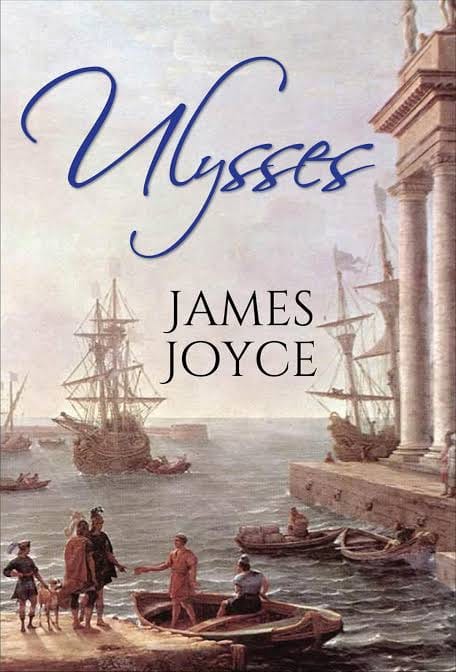
Atticus Finch, the iconic lawyer in To Kill a Mockingbird, is perhaps one of the best-named characters in all of literature. And Gregory Peck’s portrayal of Atticus in the movie version makes it impossible for me not to see Peck in my mind’s eye as though Lee conjured Peck for her incredible work of fiction.
I also think of the brilliance of the ‘narration’ by Benjy, the nonverbal, intellectually challenged (apparently) character in The Sound and the Fury. The mere rhythm of Milton’s epic poem, Paradise Lost brings the allegory to life well before any of its illustrators created the dark, luscious images of Lucifer’s fall from grace:
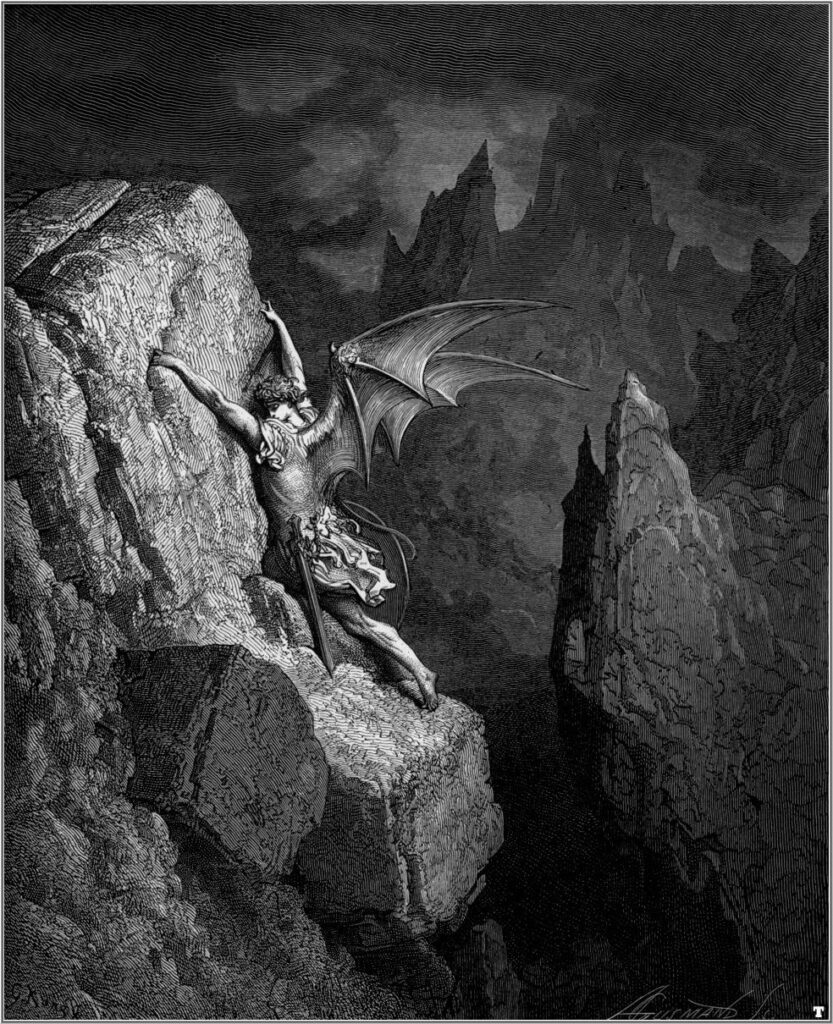
And if Homer were blind, how skilled was he in taking us into and ‘seeing’ the characters and events of both The Iliad (the story of the Trojan War circa the 12th or 11th century) and The Odyssey; the detail of The Iliad‘s chapter 23, The Funeral Games of Patroclus remains, for me, a model of both sporting description and moral behaviour. There is a wonderful fresco depicting various aspects of these Games against the backdrop of the Trojan War. It was completed in 1778 by the French artist, Jacques-Louis David; the slain Patroclus lies in state presumably held in reverence by the Greek hero, Achilles as others prepare his funeral pyre…
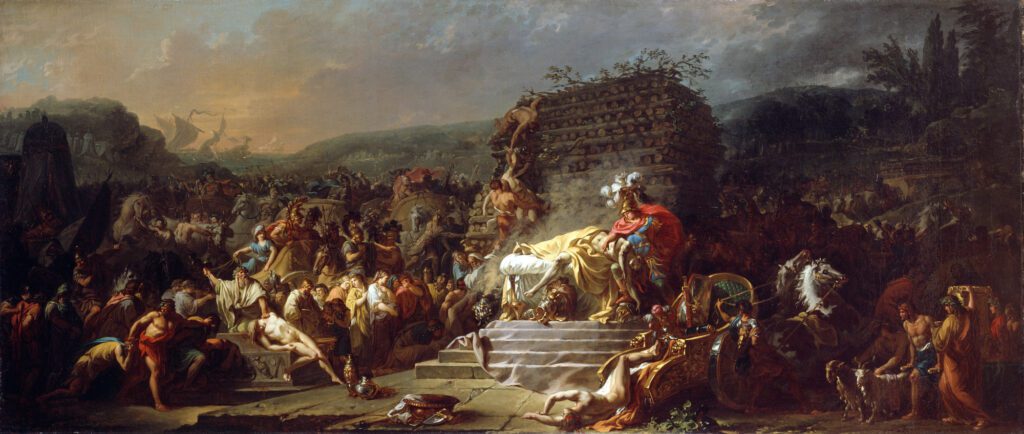
Finally, it was professors, often, and how they ‘did’ literature that cemented my allure to great works. I think of James Reany – he who did the famous plays on the maligned Donnelly family’s tragic life in Lucan, Ontario, among other works – orating from his lectern using his notes on Milton to 400 first-year students from the stage in Talbot College in the mid-1960s, long before ‘super’ or very large classes were created along with their expensive computer technology:
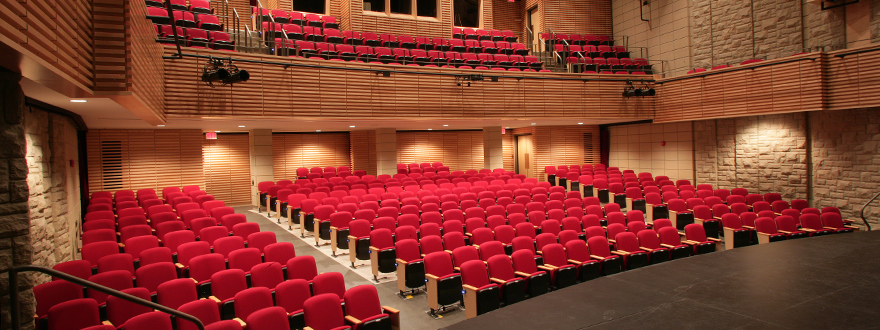
Reany held me spellbound, elegantly, mustachioed, be-spectacled, and soft-spoken.This picture of James is he some 10 years after he taught me in English 021:
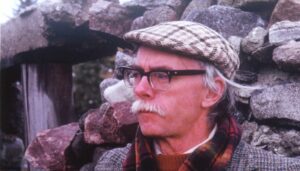
In a fourth year course, I was completely taken by Dr Larry Garber’s lessons on Yeats’ poetry; he read, emphatically and eloquently from tiny pieces of paper – the size of today’s post-it notes – on which he scribbled his lecture material. And I vividly recall Prof Elizabeth Bieman’s profound knowledge and love for Shakespeare’s works. She inspired me to take a 3rd or 4th year course that intensively examined and analyzed 13 of the bard’s plays – one play every two weeks over a full (2 terms’) course. These and so many more ‘small,’ ounce-like images are imprinted in my memory now and served to magnetize me to literature as a student.
As a professor, during the early 1980s, I became enchanted with the sub-genre world of sport literature. Somehow, I heard about the inaugural formation of the Sport Literature Association with its first – 1984, on dates surrounding my birthday – conference taking place in La Jolla, California. I knew no one who might be going, only that someone named Lyle Olsen was the organizer and the conference was to be held at the University of California San Diego (UCSD). I flew there at my own expense. Most of the speakers were from English departments and the range of topics and intellectual levels of insight astounded me…well beyond what I had expected for such a fledgling field. Like me, the speakers saw sport in its fullest sense, as a part of life no more or no less significant than any other form of human behaviour. And I blended the splendour of La Jolla into the conference with runs along its beaches, the gorgeous scenery, and amazing weather. Windows in the UCSD dorms where I stayed had no screens – there were no bugs! At night, during cooler temperature hours, the omnipresent swishing of water sprinklers was more than just audible. Lyle Olsen, a self-described “failed” baseball coach, was the most affable, unassuming academic I had ever met. The symbol or logo for the Sport Literature Association was both unique and appealing
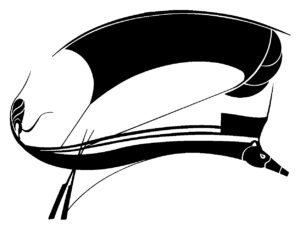
Lyle had a penchant for all things classical, particularly from ancient Greece and so the stylized argonaut ship/tireme suited his stamp perfectly. Likewise the first word in the name of the academic journal, Arete: The Journal of Sport Literature was a Greek attribute. The word arete meant, kind of oxymoronically, all round excellence. Turns out there was some other organization that already had copyrighted the name so the organization changed it to Aethlon, another Greek word that comprises the concepts of both the prize from an athletic contest and the honour of the physical and mental struggle of such contests.
My new-found interest in sport literature lead me to researching the field of known works, potential anthologies…all in the interest of creating and proposing an Undergraduate course in this area. Very quickly, I came across Tom Dodge’s 548-page, A Literature of Sports (1980):
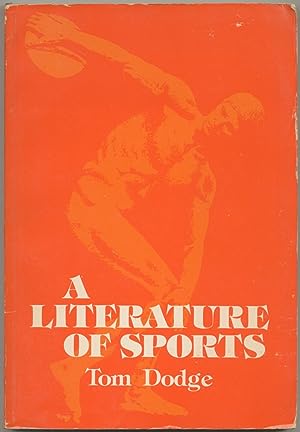
How could I not be in admiration of any book whose cover featured a subtle but visible water-marked image of the classical, ancient Greek sculpture, The Discobolus by Myron. The artwork depicts a youthful, Greek discus-thrower, caught at the moment-of-stasis, at the top of his wind-up to launch or throw the discus:
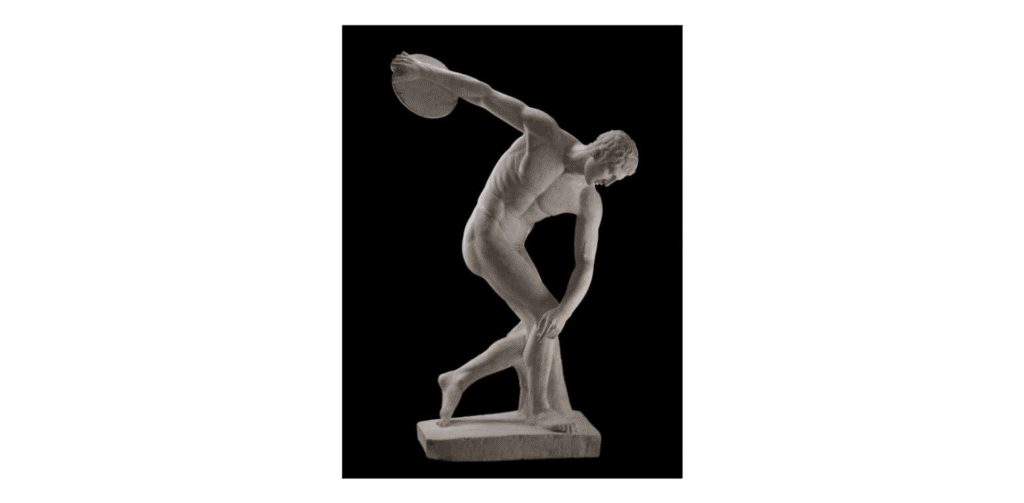
The bronze work itself is so well known in art, in the Classics, and in the field of Kinesiology. My introspective interest in the sculpture was rooted in my knowledge of the famous Canadian medical doctor, physical educator, and sculptor, Dr R Tait McKenzie. Ostensibly, Myron’s great work were it just the figure, would not be balanced enough to stand on its own. Hence, just behind the thrower’s left knee is a bronze ‘tree-trunk’ that serves to support and balance the weight of the whole piece. Sculptors and art critics were in agreement that The Discobolus would not work – would not stand upright – were it not for that supporting structure. McKenzie believed it could work on its own so he created his distinct version, The Modern Discus Thrower:
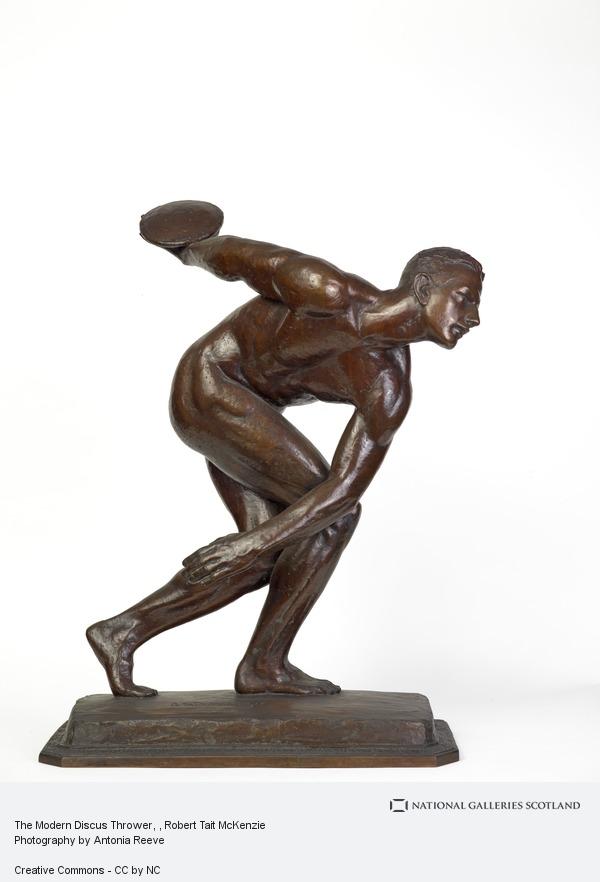
McKenzie was successful in his ‘miniature’ (not life-size) work; however, note that he had to make the athlete crouch and kind of hyper-extend the left arm, all to balance the upright stature. Modern discus-throwers spin several times in their throwing-motion (the crouch then was not a misrepresentation) whereas it is believed that ancient Greek athletes launched the discus from a standing, one-half recoil without spinning. Thus, McKenzie sought to illustrate the coiling with the crouched figure, discus firmly wrist-purchased, torso-tightened and more drawn inward than Myron’s thrower. Ironically, Myron’s discobolus not only conveys or beautifully represents movement and action, but it is also heralded for its representation of vaunted Greek ideals about proportion, harmony, rhythm, and balance; that balance had to be achieved with a tree-trunk, therein, to me, the irony.
And I do digress from sport literature. My point was to underscore my allure to Dodge’s book embedded image notwithstanding, pun intended. In some ways, the book was a kind of canned course textbook in 3 sections, works of fiction, essays, and poetry, complete with a glossary of terms, study questions (not well-crafted, in my view, but food for thoughts/questions of my own), and suggested essay topics. Armed with a potential course text and by the late-1980s, a veteran of attending some 4 or 5 annual sport literature conferences, I set out to create and seek institutional sanction for a senior Undergrad course, Sport in Literature.
New course creation in the Ivory Towers of academe was – and likely remains – a rigorous and time-consuming process. Proposals and professorial proposers have to demonstrate the relevance of course content; the ‘fit’ with existing courses and subject streams; and the likelihood of student interest, among other prerequisites to course acceptance. Convincing my peers and my Faculty was relatively easy. So too was vetting the new course through the English department, a program that might have interest in the course in terms of its students taking it; that department also had to ‘sign off’ on the course as one that had no content-conflicts with existing English courses. The last stage of the process was one in which I had to propose a course number appropriate for the content level (I chose 378, the ‘3’ indicative of a 3rd year course) and have it approved at the Senate level of the university itself. Having moved fluidly through my own Faculty and the English department (and by extension, the Faculty of Arts), I assumed the steps to Senate approval would be just as smooth, likely just a formal process working through two Senate sub-committees and then announced and ratified in a full Senate meeting.
All went well through the first Senate sub-committee and then, surprisingly, I was asked to come to a meeting of the august academic affairs and policy committee, the last hurdle in the softly complex, sometimes stifling, almost cotton batting-like world of academic processes. On the appointed meeting day, I came to the Senate office, confident in my quest and yet curious about the reasons for being summoned to what I thought would be an axiomatic endeavour. Asked to wait outside the mahogany-walled Senate meeting room until my course proposal came up on the agenda, eventually, I was invited and ushered into the meeting. About 25 academics sat around the ornate table and I was motioned to sit at one end directly opposite and a long way down from the Chair who sat at the far end, directly facing me. Happily, I presupposed, the Chair was one Prof Ninian Mellamphy, a distinguished Shakespeare scholar of Irish descent and a member of the English department. I could ‘speak’ shakespeare and his department had approved my course proposal. Without even introducing me to the committee – in retrospect, an ominous foreboding of what was to come – Ninian, wryly smiling, leaning forward, elbows on the table, pronounced firmly, with disdain I surmised, Irish brogue and all, “well Dr Morrow, what you have proposed to us is a course that matters no more than a pig in a poke!” I had no idea what the expression meant, had never heard it and have never witnessed it repeated orally or in writing to this day, but I knew from Ninian’s tone that it wasn’t a positive statement. Turns out, the idiom means, “something that is bought or accepted without knowing its value or seeing it first.”
Professors can be remarkably myopic – would obtuse be too strong? – about matters outside their own very specific areas of academic interest. We go through an incredibly introverted process of researching and writing a dissertation on a very narrow topic of particular, insular interest (the process is often derided as akin to researching how many angels dance on the head of a pin); that very narrowed topic is situated within a broad field of academic inquiry. A doctoral candidate might be educated during graduate course work in the area of biology and then choose, for example, analyzing the a specific DNA sequence in one animal for a dissertation topic and subsequent research area. Once graduated, that person might be hired to teach in the broad field of Biology, whilst retaining their specific research interest as a priority – all accepted as de rigueur in “higher” education. Thus, in fairness to Ninian, very likely, he had no idea the field of sport literature existed and yet he was a recognized scholar in the broad field of English literature. The same was true for the 25 or so committee members in that Senate room – profs in Chemistry, Sociology etc. In all probability, I was speechless after Ninian’s declaration. It wasn’t a question; it was a judgement, perhaps a conclusion…maybe a persuasive announcement to the committee members. Once uttered, still exuding that sardonic (I assumed) smile, he cast his view side-to-side as both snickers wafted in the room and dumbfounded facial expressions – like mine – were returned to his glances.
Though I was lost for words at first, turns out the Chair of the English department, he who had ushered my course proposal through his unit, was a committee member and he spoke carefully about the reasons for their decision to support the proposal. Other members of the committee asked about the extent of the body of knowledge in the area, what academic journals existed in the field, and what my research intentions were. By coincidence, Prof Peter Auksi, another member of the English department also was on the committee. Peter had been an international caliber, competitive javelin thrower for whom I had deep respect and the connections of his athletic event, ancient and modern, to my discus thrower fascination were apparent to me, opaque, probably to everyone else. Peter spoke eloquently in support of the course and reminded the committee that he chaired the sub-committee that had thoroughly scrutinized the course proposal and recommended its adoption to this Senate committee. I had spent 5 years learning about sport literature, inhaling novels like Malamud’s The Natural, Kinsella’s Shoeless Joe, Quarrington’s King Leary, and even Hemingway’s Pulitzer Prize wining, The Old Man and the Sea – could there be a more universally, life-apropos line than the latter novelist’s ‘fishing kills me exactly as it keeps me alive‘ (substitute any life activity for the word ‘fishing’). Even this artist’s jacket-cover rendering of Santiago – the handheld fishing line is an accurate rendering of the 1940s Cuban Gulf Stream deep sea fishing method for single, small craft anglers – and the marlin intrigues/d me:
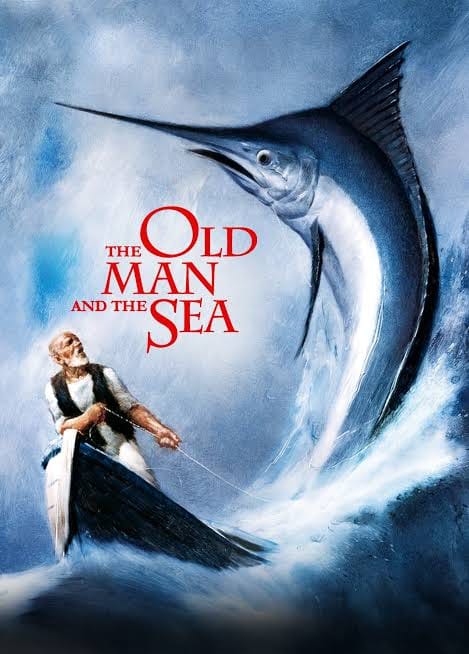
In short, armed with Dodge’s anthology, my experience with the sport literature conferences, and my extensive reading and analyses of the literature, I was prepared fully to contextualize the field and I felt very comfortable responding to thoughtful questions, hopefully dismantling the pig-in-a-poke epithet and revealing the potential value of the proposed course.
After what seemed longer than the actual time in the meeting, about 45 minutes, if memory serves, and after Ninian asked if all questions had been asked (but never asking me if I had anything to add), Ninian – who had remained silent save to direct the questioning – asked me to leave the meeting so that committee members could discuss and vote on the proposal. Weeks passed before I received a letter, maybe a memo – these were pre-email days – stating that the Senate committee approved the course and it would be ratified by Senate at its next meeting. Sightly uncertain about the outcome of Ninian’s committee deliberations, my read of the ‘room’ as I left that meeting was one of congenial support; nevertheless after learning the formal decision, I was both relieved and thrilled.
Everything happens for a reason, even in academe where decisions are made slowly; endless committees are struck (for god so loved the world, s/he didn’t send a committee); agendas are buttressed by self-interests – to coin and paraphrase another Greek expression, ‘the wheels of the academic gods do indeed grind slowly but they grind exceedingly fine.’ Patience is an academic’s necessitated quality. Start to finish, my course proposal took over two years. Its sanction did attract the interest of the Dean of the Faculty of Part-Time and Continuing Education, Dr Angela Armitt and her successor, Dr Carole Farber. At the time, all extension courses were offered through that Faculty. Carole encouraged me to transform my course into a self-learning format as a manual that contained all course readings (not the novels), a schedule of lessons and lesson plans, and audio tapes for each unit of the course. The result was Physical Education 178, offered for several years as intersession and/or summer courses. That manual took me months to create and it remains one of my most prized teaching-creation documents. At the time, I did not type; secretaries did most academics’ typing, so I do not have a digital copy of the manual. Putting that document together was of immense help in finalizing my course structure for its regualar academic year offering as PE 378.
From its inception until its final iteration as the last University course I taught before I retired in 2016, the broad structural content or course ‘themes’ remained constant:
Introduction
Fantasy
The Participant
The Spectator
Aesthetics
Film and Literature
Sport and Life
Exhilaration/Love
Humour
Death and Dying
Ritual, Religion and Myth
The content – novel selections etc – changed frequently but the life/sport themes worked for me as a way to deliver, discuss, and analyze sport literature with students. More than any other course I taught, I loved teaching students about sport literature. There was so much room for both appreciating the literature, deriving meanings from sport, and for including students’ experiences, opinions, and beliefs about sporting behaviour and meaning in their lives.
As is my wont with most everything I do/did, I immersed myself in the field, first in creating a substantive and, I hoped, interesting course – the 178 and 378 versions mentioned above – and then initiating an area of research interest hopefully to enhance the literature of sport and fulfill my professorial obligations to do research and publish. My very first foray into sport literature research was borne from my desire to show what meanings could be derived about the human condition exemplified through sport. In some ways, I suspect, I wanted to show the ninians of the academic world that literature with sporting themes was of value. Moreover, I sought to establish myself as a legitimate, researching academic in the field. Subconsciously I suppose, I knew Ninian’s scholarship was grounded in Shakespeare’s works. And I had studied the bard’s poems and plays. Was there something I could glean about sport from the canon of Shakespearean literature, specifically his 37 plays?
Determined to find a way to ferret meanings about sport from the plays, I set up a regular schedule to spend time in Weldon Library (the main library on campus) combing both the plays themselves and the published analyses of them. I had kept all my copies of the Shakespearean plays I had studied as an Undergrad, those Arden paperback, Methuen-published versions that I raked again to ferret meanings and nuances related to themes, sport, and expressions. Below, a page from my King Lear version, complete with scribble notes and ubiquitous underlining I did as both student and prof:
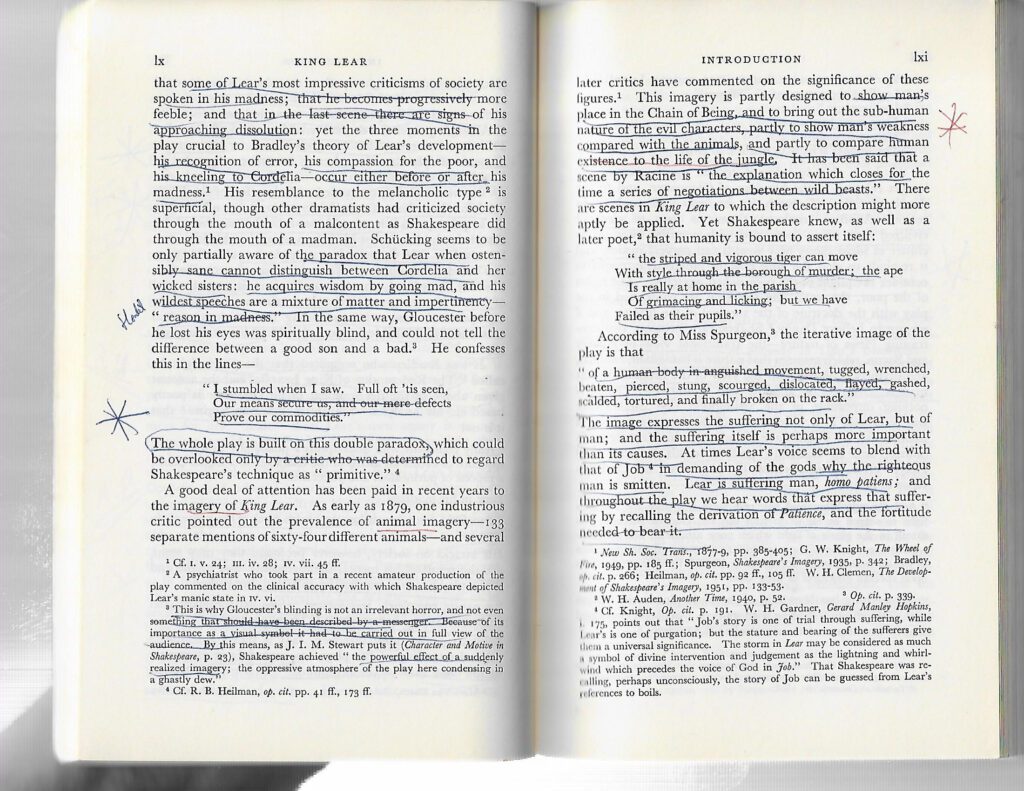
Very quickly, I realized I faced a daunting task and needed to find a way to get some kind of sampling technique or method…some way of dissecting or tapping into the plays without having to go through all 37 of them line-by-line. Quite by accident, I think, in going through the card cataloguing system at the time, was finding what turned out to be an invaluable compendium, Caroline Spurgeon’s Shakespeare’s Imagery and What it Tells Us:
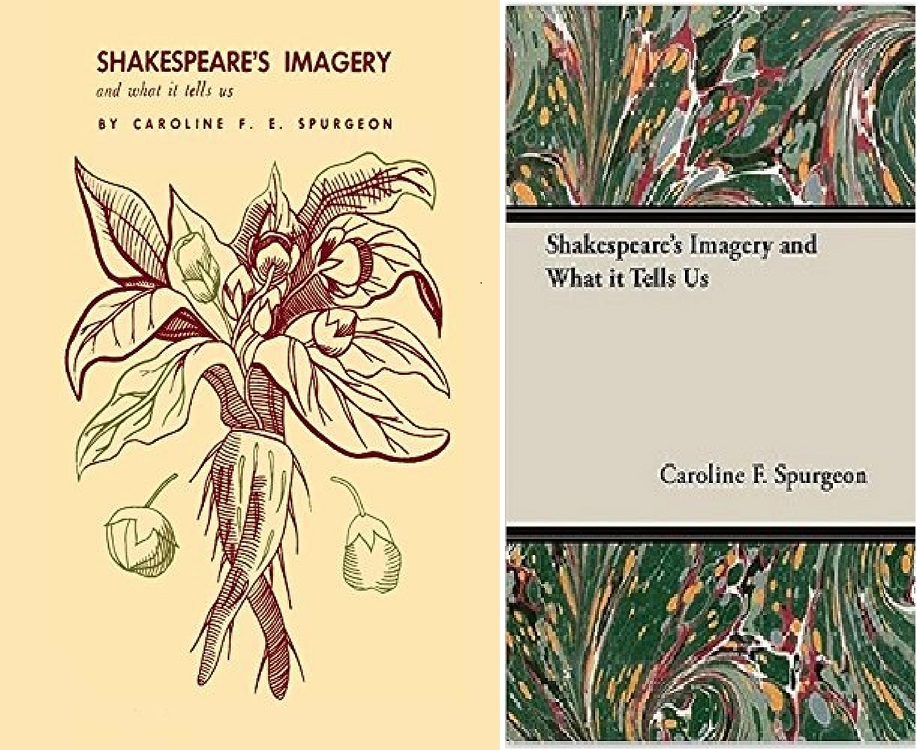
Spurgeon’s original 1935, 444-page edition on the left and the reprinted 2013 version on the right
Our library had a hard-cover, blue-bound 1935 copy of the book. Spurgeon, a Geoffrey Chaucer scholar, 65 years of age at the time of publishing her Imagery book, had combed all 37 plays to list and then categorized all – every single one – of the images/imagery in the plays. For me it was a golden find, a treasure-trove. When I think about her work now, pre-computers, pre-digital files, pre electronic scanning of any kind, it is just stunning to realize she did this work all by hand, literally going through each play, line by line to create her compendium.
In general, imagery and images in all literature but specifically in the plays serve a specific function in my view, namely to point a metaphorical finger at human nature. Aside from Spurgeon’s work, there were and are published articles and books on pretty much every aspect of Shakespeare’s views upon and imagery connected to religion, mythology, honour, morality, ghosts, music, law, science, beauty, pregnancy, heroes/heroines, fools, humour etc. Curiously to me at least, the dramatist’s perspective upon and the function of the imagery connected with/to sport has been ignored. There seemed to be a tacit assumption that his use of sport and sport imagery is trivial and unimportant. Coincidentally, that generalized assumption is likely the raison d’être for the creation of the whole academic field of inquiry connected to Physical Education/Kinesiology – traditional academic faculties did not treat sport/play/games as serious human endeavours. In the same vein, sport literature came about for that very reason; orthodox literature courses did not include literature about sport. As for the plays, one researcher, Rebecca West seemed to champion this inconsequential notion about sport in the plays when she opined, “Shakespeare is a bore only when he is writing of the joyful occasions when men and women gather together to have a good time by the exercise of sports and games and indulgence in wine and bawdry [obscenity]. Unlike the average [person], he was at his best in crises, when the gods came to earth to wrestle [ironically, her sporting terminology] for the souls of [people].”
My developing perspective at the time was that the reason the playwright’s sporting terms and phrases were perceived as boring likely was due to the fact that very little was/is known about sport during his time compared to general knowledge about music, law, pregnancy, and so forth. In fact, the nature and significance of sport in the late 16th and early 17th centuries – the 37 Shakespearean plays were written in between (about) 1590 and 1613 – was very much different than the modern sport meanings and forms. It seemed to me that modern audiences might be naive about Shakespeare’s sport references because the form and function of sport has changed so much. Some researchers, I found, sought to use the bard’s sporting imagery to ‘prove’ he was a hunter, a fisherman, an archer, an ornithologist or whatever. What enlivened me and my research endeavour from Spurgeon’s book was her revelation that her classification of images in the plays provides solid, quantitative evidence of the numeric and proportional significance of sport imagery in the plays.
Of the eight major categories of images she identified, the largest category was that of images of daily life. And within that category, the sub-category “Sports and Games” contained the greatest number of images. Compared to five of Shakespeare’s contemporary dramatists (Marlowe, Ben Jonson, Chapman, Dekker, Massinger), Spurgeon found in isolating the category of daily life images, that the number of images of sports and games was greatest in the plays of Shakespeare and that of the six dramatists, the largest sub-category of daily life images, viz. sports and games, was unique to Shakespeare. Thus, it can be interpreted that, relatively speaking, Shakespeare used sports and games images abundantly. The remarkable feature about the amount of sport imagery used by Shakespeare is its juxtaposition with a period that is acknowledged to be anything but a watershed in the history of sport.
Sport imagery logically, would have to be suited to the knowledge of Shakespeare and his contemporary audiences regarding sport itself. The plays do reflect the sporting behaviors of the Elizabethan and early Tudor era. England at the time was emerging from feudalism and its traditions toward a different social fabric of which sporting behavior was commonplace, an integral part of daily life. Sports related to hunting, angling (fishing), animal baiting – a very cruel but apparently very popular form of sport; the London Globe theatre, the site for live performances of the plays, doubled as a bear-baiting and cock-fighting facility, the events caricaturized below: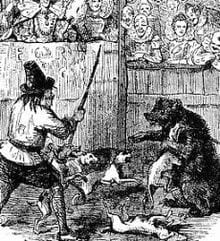
Bear-baiting at the Globe Theatre
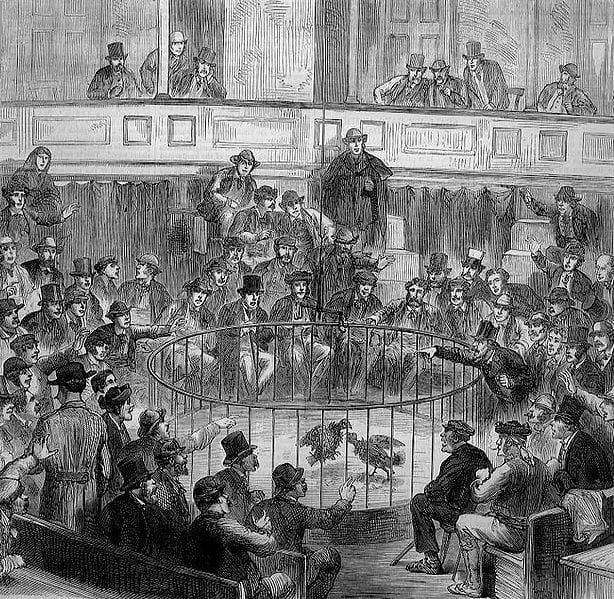
Cock-fighting at the Globe
Regarding bear-baiting, Shakespeare’s references are subtle and would not be lost to his contemporary audiences. For example, When Macbeth is cornered in Dunsinane castle he sums up his situation in that sport’s terminology and format wherein a bear’s leg was chained to a stake and dogs were incensed to fight the larger animal,
‘They have tied me to the stake; I cannot fly/ But bear-like I must fight the course.’
Difficult to understand, let alone sanction in contemporary society, sadly cock-fighting still exists, primarily in Southeast Asia where billions of dollars in revenue are made annually.
Most of what I learned and taught about English sport in general and falconry or hawking in particular during this time period was gleaned from Joseph Strutt’s 1801 Sports and Pastimes of the People of England with the delightful subtitle, Including the Rural and Domestic Recreations, May Games, Mummeries, Shows, Processions, Pageants, and Pompous Spectacles from the Earliest Period to the Present Times. That sport was framed with other pastimes like shows, pageants, mummeries (masked play-acting) etc shows Strutt’s view of the contextualized significance of sport alongside those recreations. The book is still very well respected and even now sells, in a 2007 reprint version, on Amazon). Other forms of 16th and 17th century sports included archery, wrestling, fencing, jousting, tennis, lawn bowling, football (soccer, to North Americans), horse-racing, and falconry; all were prevalent, although restricted by type, expense, and appeal to different social strata. Obviously these sports were pre-industrial in nature, that is, lacking in the organization, regularization, and standardization with which we are so familiar. The opportunities for gambling and betting must have been an extremely strong contributing factor to the popularity of sports and recreations at all levels of society during these centuries. In teaching sport history, one of my maxims about sport and human nature was, if it moves why not race it..and if you race it, why not gamble on the outcomes – gambling and sporting endeavours have been and are inextricably interwoven for centuries.
Pictures and accounts of sport during Shakespeare’s time are relatively rare – witness the almost crude animal baiting sketches above. However, one very accurate re-enactment of Middle Ages’ sport, jousting was portrayed in the movie, A Knight’s Tale featuring Heath Ledger – see the full joust scene here. Jousting participants were upper class but spectators were from all social strata. Intriguing to me is the current revival of interest in things Medieval inclusive of feasts wherein utensils are abandoned and food is consumed while ‘knights’ mock-battle in jousting re-enactments. And there are a great number of recent published works that have analyzed the physics of jousting – the riders’ armour weight; the speed of the horses; the horizontal holding of a 10-foot lance; and the impact of that lance on riders, all have been studied and assessed in order to appreciate that sporting form.
For specific reasons that escape me now, I selected one sport, falconry or hawking, on which to hone my research into the plays. For the most part, I used Strutt’s chapter 2 on Hawking, currently available as a Gutenberg EBook reprint of an 1845 edition of the book; I copied that chapter with copyright permission and the full hawking chapter is available here. Falconry is the 4000-year-old art and sport of hunting wild birds, rabbits, squirrels, and other animals with trained raptors, or birds of prey. Raptors all have a curved beak for tearing meat, talons for gripping and grabbing prey, forward-facing eyes for keen sight, and they only eat meat. The raptor category includes hawks, eagles, owls, osprey, kites, secretary birds, vultures, and falcons. Some stylized images of falconry and falconers from the 10th through to the 19th centuries is this set:
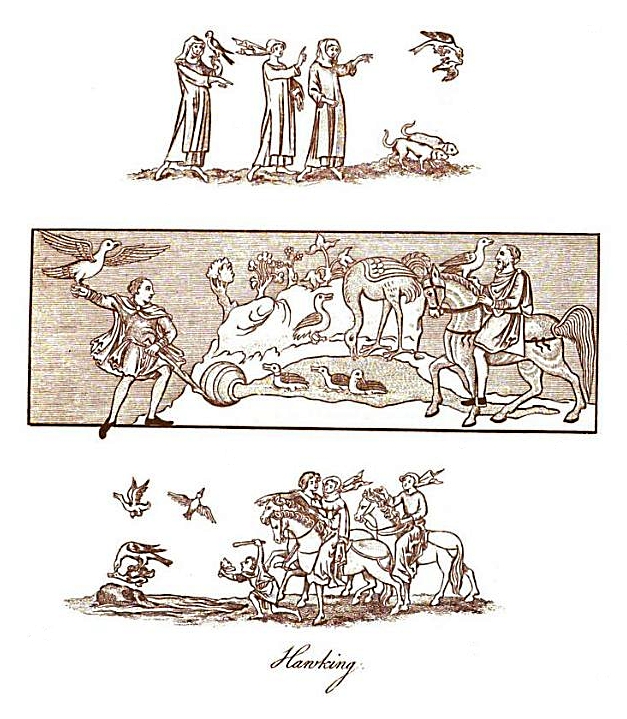
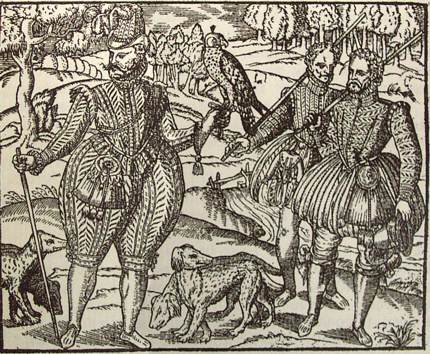
Hawking. From Turberville’s Book of Falconry, reproduced in Shakespeare’s England
Some of the equipment – gloves, hoods, bells – for the sport today looks like:
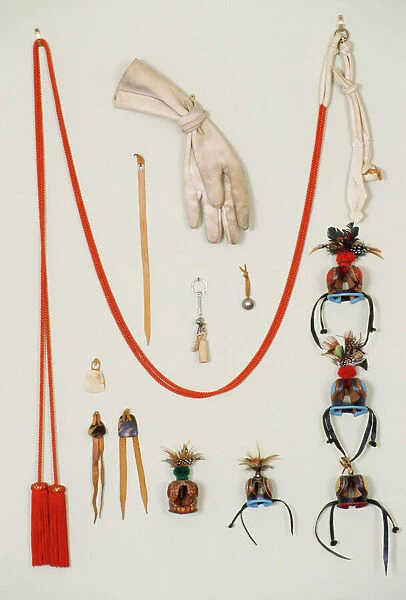
Today, the sport is legal in Canada and elsewhere; more information on the contemporary form of the sport can be found at this link. My reflection on the choice of sports now is that I wanted a sport little understood in the organized, team-sport dominated world of modern times and I kind of sought to set myself up to use one sport to show the richness of the playwright’s use of this sport in his imagery. The use of and meaning attached to sport imagery in the plays is far greater in significance than merely acknowledging that this imagery was a touchstone of Elizabethan sport. Of critical significance in Shakespeare’s concept of sport is the spirit or attitude of pleasure brought to the activity. An example from the first play he ever wrote is characteristic. The second act of Part 2 King Henry VI opens with a hawking scene during which the Cardinal laments to Gloucester:
Believe me, cousin Gloucester,
Had not your man put up the fowl so suddenly
We had had more sport.(Act II, scene i, pages 46-48)
The Cardinal’s complaint is not directly related to a wish for better or more productive hunting, rather it is for more sport. It is the thrill, the pleasure, the spirit of the chase that is significant to Shakespeare in sport as in any human conquest. Nowhere is this better encapsulated than in The Merchant of Venice:
All things that are,
Are with more spirit chased than enjoy’d. (II.vi. 12-13)
And if memory serves me, somewhere on the box of the immensely popular, 1981-released board-game of Trivial Pursuit
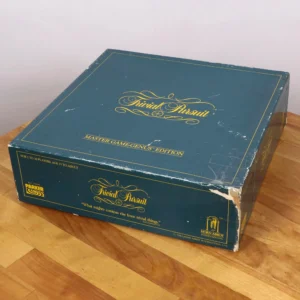
was the blinded Gloucester’s lament in King Lear wherein the word ‘sport’ can be replaced with the term, pleasure:
As flies to wanton boys are we to the gods; / They kill us for their sport (IV.1, 37-38)
At the time of doing my falconry research, I actually knew about that Trivial Pursuit box quotation and quite possibly used that knowledge in selecting Shakespearean era sport and falconry for my first research and writing re sport literature. Interestingly to me and by coincidence re this blog, in 2018 a Shakespeare edition of Trivial Pursuit was released:
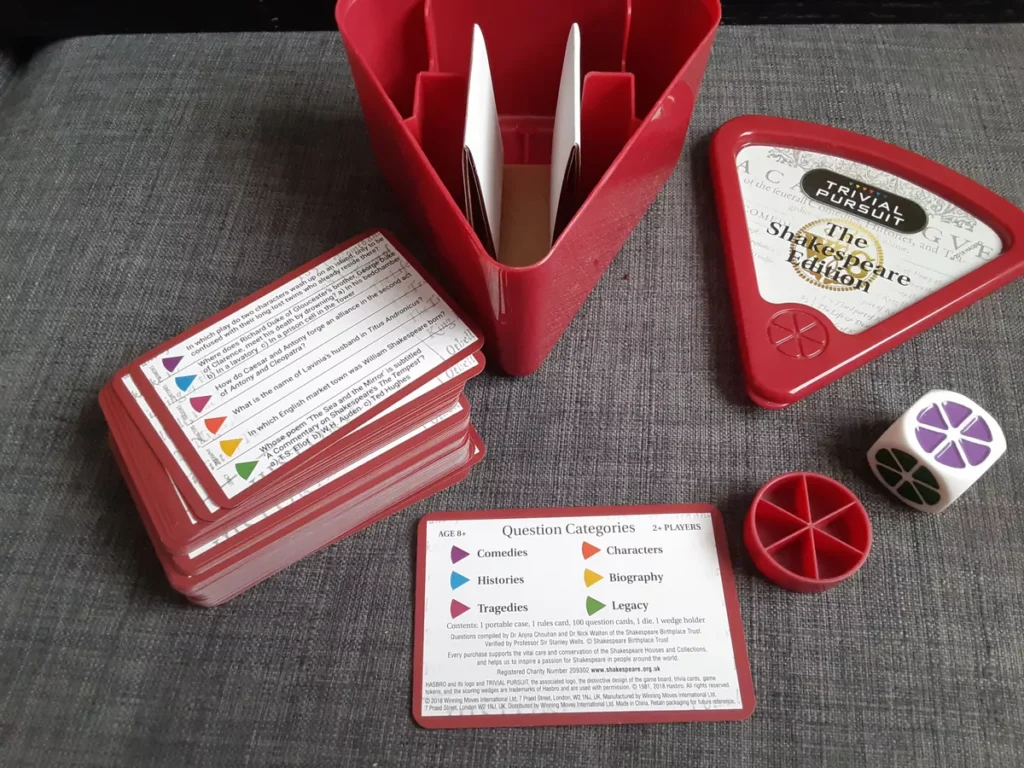
I have not looked at this volume as yet; would be intriguing – perhaps only to me – to know how many sports and games’ trivia questions are among the 600 questions included in this game version (6000 questions in the original 1981 edition).
Back to my project and the pleasure principle of sport that was elemental to Shakespeare’s audiences. The first 24 of the 37 plays are replete with sport imagery. Plays written after 1602 do not contain nearly the quantity of sporting imagery as the earlier plays. Shakespeare’s shift in these later plays to dark tragedies and more complex, serious themes did not lend toward the extensive use of imagery that connoted pleasure or amusement. As a case in point, compare the use of fishing (angling) imagery in Much Ado About Nothing with its use in Hamlet:
The pleasant’st angling is to see the fish cut with her golden oars [fins] the silver stream /And greedily devour the treacherous bait; So angle [fish] we for Beatrice; (Much Ado 111.i. 26-29)
A man may fish with the worm that hath eat of a king / and eat of the fish that hath fed of that worm(Hamlet, IV, iii. 27-28)
The former image is both unique and beautiful yet still much more meaningful than a mere tribute to the sport of fishing. The angling image taken from Hamlet is perfectly in keeping with the moods in that play of rottenness and corruption. The images are not images about sport; they are metaphors used to demonstrate beautifully or repulsively, respectively, some aspect of human nature critical to the theme of each play. Moreover, both passages change the normal image, with Shakespeare’s insight, to a new pattern of thought. Thus, the transformation of fins to golden oars, or of the unique life cycle of the fishing worm is metaphorically akin to asking a person to tip, mentally the letter ‘N’ on its side – the letter ‘Z’ is imaged; the bard wanted us to hear/see different perspectives in his use of imagery. In like fashion, Shakespeare uses sporting imagery to transform some facet of human nature into reflected meaning for his audience. The sporting imagery becomes a conceptual peg on which to hang a general idea or to reinforce a theme.
The most beautiful and most poignant use of sport imagery in the plays, in my view, is centered around the at-the-time universally popular sport and utilitarian endeavour of falconry or hawking. Hawking as a sport had a vocabulary that was all its own in Shakespeare’s time, comparable to the sporting vocabularies we use today in both team and individual sports. For the elite strata of society, Spurgeon maintains that hawking or falconry was “more studied than the Greek or the Latin.” For example, there are copyrighted, hawking-scene sketches featuring Queen Elizabeth I partaking in the activity. At the same time, there was a universality to hawking; everyone who could afford it kept a hawk. The rank of the owner was indicated by the species of bird which he carried:
The eagle, the vulture, and the merloun, for an emperor.
The ger-faulcon, and the tercel of the ger-faulcon, for a king.
The faulcon gentle, and the turcel gentle, for a prince.
The faulcon of the rock, for a duke.
The faulcon peregrine, for an earl.
The bastard, for a baron.
The sacre, and the sacret, for a knight.
The lanere, and the laneret, for an esquire.
The marlyon, for a lady.
The hobby, for a young man.
The gos-hawk, for a yeoman.
The tercel, for a poor man.
The sparrow-hawk, for a priest.
The musket, for a holy water clerk.
The kesterel, for a knave or servant. (Strutt)
If the terminology is understood, the falconry metaphors and images are powerful. The spirit of sport then, was strong to Elizabethans, and Shakespeare played on their sporting proclivities and interests. As D. H. Madden states in The Diary of Master William Silence: A Study of Shakespeare and Elizabethan Sport, Shakespeare’s knowledge of falconry was intimate: “In his use of this knowledge for the illustration of human character, thought, and action, he stands alone.” In fact, Shakespeare over-used his falconry imagery in that falconry and other sports of Shakespeare’s England are anachronistically attributed to Egyptians, Athenians, and Romans, as noted by Lascelles in his 1916 book, Shakespeare’s England: An Account of the Life and Manners of His Age
So great a hold had falconry taken upon the minds of country folk in Elizabethan times that its technical terms were habitual to ordinary conversation. To the reader or play-goer of Shakespeare’s time the technical terms describing the training of hawks for the sport of falconry were household words.
Therefore, falconry could be used easily and freely by Shakespeare as a metaphor for life, for human nature, or, for plot, theme, and character development since it was so much a part of everyone’s life.
The basis of falconry centred upon the manning or training of the hawk by a falconer, or, by its owner, the sportsman. The ideal hawk was the female falcon or peregrine falcon. It was larger than the male or tercel hawk, had longer wings, was faster, and felt to be much more bold than the male or tercel. Hawks were best trained or manned, before they went wild or haggard, by teaching them to prey upon an artificial lure made of wood and raw meat. The lure was manipulated with a string by the falconer in order to bring the falcon back when she struck or missed the lure. The lure was retracted and paired with a verbal call unique to each falconer. Thus, when Juliet, in the play Romeo and Juliet, pines,
O, for a falconer’s voice, / To lure this tassel-gentle back again! (II.ii. 58-59)
the image to Elizabethans was sporting, aptly applied to Romeo as a tercel. The image transition to the lovers in the play could be made instantly even though the falconer/hawk roles were reversed. Modem audiences would miss the subtlety of Juliet being Falconer; they would not understand the true meaning or double meaning of the word lure. The full richness of the metaphor is dependent upon a familiarity with falconry. In fact, it may be that falconry example in Romeo and Juliet represents a particularly complex metaphor for the sexual quest and and even for representations of a peculiarly dis-empowered masculinity. In the latter regard, it may be that such dis-empowerment is a contemporary perspective, not one Shakespeare explored. At the same time, the bard was an extremely clever writer and it may well have been his intent to mock the nuances of traditional masculinity of his era.
Scholars argue – they do that in determining the number of angels dancing on the head of a pin – that Shakespeare was familiar with George Turberville’s The Booke of Faulconrie or Hawking, first published in 1575. The inference made is that the playright drew upon Turbervillle’s work as a central resource in his writing. While that may be the case to a degree, the falconry images are so rich, so precise and appropriate that it is difficult not to believe that Shakespeare was as versed in the falconry vernacular – reinforced by book-learning, perhaps – as he was with any of the other aspects of daily life images, to use Spurgeon’s categorization of imagery.
In training the falcon one of the first steps taken was to tie jesses or short leather straps to the legs of the hawk. To these jesses, small rings of silver, often engraved with the owner’s name were attached. The rings or “bells” were not only for identification, but ringing in the wind they were believed to terrify potential prey. And so the ominous threat of Warwick is demonstrably apparent in:
Neither the king, nor he that loves him best, / Dares stir a wing if Warwick shake his bells. (Part 3, Henry VI, I.i. 45-47)
This historical play is a study in the anarchy of the state, the family, and the mind of the individual, especially the evil, conniving Richard III. Warwick, fierce in battle, is depicted as the falcon instilling fear in all potential prey and there is the suggestion of bawdy humor if balls are substituted for bells. Was Shakespeare mocking the inanity of presumed male superiority wrought by rumored ferocitv of battle when all in his audiences knew the hunting prowess of the female falcon?
In captivity the hawk wore a small hood to keep it owner-dependent. Using Romeo and Juliet again, the necessity for and complexity of restraint in human emotion is implied in the falconry metaphor:
Hood my unmann’d blood, bating in my cheeks / With thy black mantle. (III.ii, 14-16)
Very likely, our modern expression, to be hoodwinked (fooled) by someone, has its roots in falconry jargon. Romeo and Juliet is a whole play that celebrates the active beauty of the body, and Shakespeare makes us feel the intensity of the body’s imperatives of food, exercise, rest, and sexual desire. The lover’s plea to curb desire is completely compressed in the falconry metaphor through the use of training terms not customarily associated with human emotion.
Not only was the hawk mantled or hooded, but its eyelids were strung by thread from one lower eyelid, up over the head and through the other lower eyelid. As training progressed, more and more was the tension on the thread released to permit greater vision. The whole process was called seeling and Shakespeare makes repeated references to the technique of seeling in his imagery. The verb “seel” is lost in its full implication – possibly heard and interpreted now as ‘seal’ – in the following lines from Antony and Cleopatra:
The wise gods seel our eyes; / In our own filth drop our clear judgment; make us / Adore our errors. (III.xi. 112-114)
The gods, obviously become falconers training humans, but with a twist on free will to make errors in judgment without realization. In similar fashion a daughter’s ability to dupe her own father by pretense is highlighted in Othello with reference to Desdemona who
could give out such a seeming / To seel her father’s eyes up close as oak. (III.iii. 209-210)
Falconers released their hawks upwind. If flown downwind early in the manning process, often the falcons would not return. Birds found useless or too haggard (wild) for training, were let go downwind. The character Othello, mistrusting the faithfulness of Desdemona, compares her to a hawk in the following proclamation:
If I do prove her haggard, / Though that her jesses were my dear heart strings, / I’d whistle her off, and let her down the wind, / To prey at fortune. Othello, III.iii. 260-263)
The metaphor bursts with meaning because of the falconry metaphor. Could a modem audience appreciate the suitability of jesses being compared to heart strings? Othello in the metaphor is both falconer and male falcon, and his expression of devotion is reinforced by the comparison. Fully understood, the whole play takes a grip on its audience’s emotions; since the characters are from ordinary life, the falconry imagery and metaphors underscore the tragedy with clarity to Elizabethan audiences.
Just as easily, the recovery of an entire nation could be compressed by the bard into a hawking image:
If then we shall shake off our slavish yoke, / Imp out our drooping country’s broken wing. (Richard II, ID.i. 291-292)
Imping was a well known technique describing the intricate process of repairing a bird’s damaged wing. Lost on contemporary audiences in its full meaning, the statesman aptly expresses his wish to redeem the broken fortunes of his country Similarly, a simple verb, “check,” referred to the tendency of a falcon in early training to fly at an alternate target or prey in distraction from the intended quarry. Check is used in this sense in at least four different plays and can best be illustrated in Viola’s speech about the intended targets of the Clown’s humor in Twelfth Night:
This fellow’s wise enough to play the fool; / And to do that well craves a kind of wit: / He must observe their mood on whom he jests, / The quality of persons, and the time; / And, like the haggard, check at every feather / That comes before his eye. (ill.i. 58-63)
Congruent with the use of masques in the comedy of Twelfth Night and the constant recurrences of mistaken identity, the Clown’s comparison to a haggard checking at false prey is especially suited to the theme even though there is very little actual sport or use of sport imagery in this play. Once again, then, Shakespeare utilized sport metaphors to suit his intentions in the plays, yet many metaphors of sport are oblique to contemporary readers and theatre crowds.
The sheer marvel of the whole falconry hunting prowess was the fully trained hawk performing its task to perfection, the timeless ideal of any sport. Shakespeare reproduced a plausible conversation held by a party returning from a successful day’s hawking. The limits of human possibility or potential are compared in clever and unique fashion to the supreme height – the ‘point‘ below – attained by the hawk, in the opening scene of the second act of Part 2, King Henry VI:
King: But what a point, my lord, your falcon made /And what a pitch she flew above the rest! / To see how God in all his creatures works! / Yea, man and birds are fain of climbing high. / Suffolk: No marvel, an it like your majesty; / My Lord Protector’s hawks do tower so well; / Thev know their master loves to be aloft, / And bears his thoughts above his falcon’s pitch. Gloucester: My lord, ’tis but a base ignoble mind / That mounts no higher than a bird can soar. / Cardinal: I thought as much; he’d be above the clouds. (11.i. 5-15)
This History, Shakespeare’s first play, concerns the Plantagenet dynasty and develops the themes of crime and punishment and the evils of weak government. Furthermore, the whole play is full of imagery of the jungle, of hunting, and the slaughter-house since it was characteristic of the Middle Ages and Renaissance to think of lawlessness and turmoil in terms of animals. In the quotation above, the apparent metaphor of the limits of human possibility to the pitch of a falcon runs deeper and more “pointedly” toward the aggravations, quarrels, and animosities of the nobles against Gloucester. The lines are actually clever puns that poke jibes at Gloucester whose noble’s badge or insignia was a falcon with a maiden’s head. The mental image drawn by the word ‘point‘ in the King’s speech in Part 2 King Henry VI (cited above) catered to the experienced falconer and perfectly described the tiny portrait of the falcon having soared to its highest place or pitch just before its awesome, full-speed swoop to attack its prey. The same image is used for like effect in Richard II:
How high a pitch his resolution soars! (l.i. 109)
and is turned upside down for ominous effect in Macbeth to portend darker events:
A falcon, towering in her pride of place, / Was by a mousing owl hawk’d at and killed. (II.iv. 12-13)
The mousing owl would not be able to have such an impact on the more powerful falcon – therein lies the foreshadowing of unusually menacing occurrences. In every case, the falconry imagery carries meaning well beyond the allusions to the sport itself.
The Taming of the Shrew, one entire comedic play, is totally constructed around a falcon-shrew hunting image. The shrew was a small land animal greatly hunted by every manner of hawk. In the play, the double entendre of the word, shrew is its mammalian sense and secondly in the sense of an offensive word for a woman who is considered to be unpleasant and easily annoyed, and who argues a lot. The play’s title is, in the literal sense, an absurdity in that animal-shrews were not tamed for pets and such tiny animals could do no useful work. Yet the title fits what some scholars believe to be one of the central tenets or themes of the play, viz. the absurdity of male supremacy (the female hawk was the preferred sporting falcon, for example). The whole play could have been staged in a manor house since it is so full of images of the chase, the tavern, and the hunting habits of lords and their servants.
The first three acts explore the characteristics of the shrew followed by the last two acts that concentrate on the single process of manning or training a wild hawk for hunting the shrew, that is, reducing the haggard to obedience so that she can hunt with you and for you. The resolution of the falcon/shrew conflict uses all kinds of technical terms of falconry metaphorically to refer to human characteristics and behavior. Conflict resolution is the essence of dramatic comedy. By way of brief example, Petruchio, the falconer, refers to Katherine, the shrew, as his haggard in the following speech:
My falcon now is sharp, and not passing empty, / And, till she stoop, she must not be full-gorg’d, / For then she never looks upon her lure. / Another way I have to man my haggard, / To make her come and know her keeper’s call; / That is, to watch her, as we watch these kites / That bate, and beat, and will not be obedient. She eat no meat today nor none shall eat; / Last night she slept not, nor tonight she shall not. (IV, i. 193-201)
The double meaning of the falconry terms of training (especially stoop or swoop, the rapid descent of the hawk to attack the quarry) to the characters in the play and to character in general were readily apparent to Shakespeare’s audiences in this brief passage and throughout The Taming of the Shrew. The resolution of conflict is the essence of comedy and the main objective of training a Falcon to sport. Without considerable explanation into falconry, it is curious how The Taming of the Shrew can be both enjoyed and fully comprehended today.
The metaphor for sport, in particular the example used in this paper, falconry, is life or human nature itself – human nature is the principle subject of Shakespeare’s plays and sport is no more or less used than any other set of images by Shakespeare. In examining the falconry imagery specifically in the plays it is difficult not to notice, with some insight into the vocabulary of falconry, the emphasis Shakespeare places upon the spirit of sport, the chase, the training, the enjoyment or pleasure taken in the pursuit rather than the outcome of sport. Once again, in my view, such is the true essence of sport no matter what form it takes.
From a 20th-century perspective, in hindsight, on the literature of Shakespeare, it is equally evident that many of the terms of the sport of falconry have evolved into concepts that are now integral to other forms of modem sport and/or the terms have implications for the structures, functions, and values of contemporary sport. In the latter regard, it would seem of at least etymological significance that manning was the term used for training when one considers real or assumed male dominance in the world of sport. The dietary restrictions in the training of hawks prior to the hunt, the “mews” or training stables have their contemporary training table counterparts.
In the same vein, the falconer served the dual roles of trainer/coach and the cadgel was a servant who carried the trays of falcons into the hunting area. Is the cadgel of falconry the caddy of golf? The time-honored act of throwing a handful of grass into the air to test for wind direction was as much a part of the process of falconry as it is of golf or track and field today. Terms from falconry such as check and point would seem to have derivatives in the concepts of checking (picking up your check when on defense etc.) in several team sports. The term ‘point,’ not in the scoring sense but in its positional sense in cricket or ice hockey (“back to the point” or, the old 7-man positional, cover point position in ice-hockey), just as it was a positional description in falconry.
When we teach tracking skills in movement education, is it not just a different form of the same idea pursued in falconry for the same reason in the process of seeling the hawk’s eyes? I hesitate, briefly to suggest that “how high a pitch” might have some carry-over to baseball; but I have to think the use of bells on the jesses of hawks is somewhat transposed to bells on figure skates, bells used in refereeing many sports, bell laps, etc., and that the hawking term ‘let’ reappears in the allowance for a re-play in squash, tennis, and other games.
Thus, the sport of falconry is a rich and loaded source of metaphorical meaning in Shakespeare’s plays. My assumption is that falconry was both utilitarian – hunting for food basics especially among members of lower social echelons – and sporting. Certainly, Shakespeare’s treatment of the activity reflects the sheer joy and pleasure of falconry regardless of its end-functions. Along with the metaphorical and image devices associated with other sports in the plays – billiards, lawn-bowling, tennis, football/soccer, for example – the falconry imagery contributes greatly to an appreciation of the plays in the same manner as any other example of imagery except that sport imagery – most certainly that of falconry – rarely has been seriously studied, analyzed, and explained to modem audiences.
This discussion underscores the nature and significance of Shakespeare’s use of falconry as a metaphor and image source. Moreover, the timelessness and universality of meaning in Shakespeare’s plays can be traced to the sporting terminology carried to contemporary sports in concepts such as check, point, let, manning, and so forth. Just as there is in playing or watching sports, there is a richness to the manner in which sport, its players, its frivolity, its athleticism etc is explored in a growing body of literature, inclusive of Shakespeare’s plays and the bard’s careful and skillful use of sporting imagery. For some reason, I just ‘got’ Shakespeare’s language…in the manner, I suppose that some people ‘get’ math or statistics; his language use intrigued me – how many entire soliloquies did I memorize and write verbatim on English literature examinations in both high school and university – and was certainly a factor in choosing to examine falconry academically. And I can’t resist including this example of ‘poking’ fun at the bard’s language had he composed The Hokey Pokey:
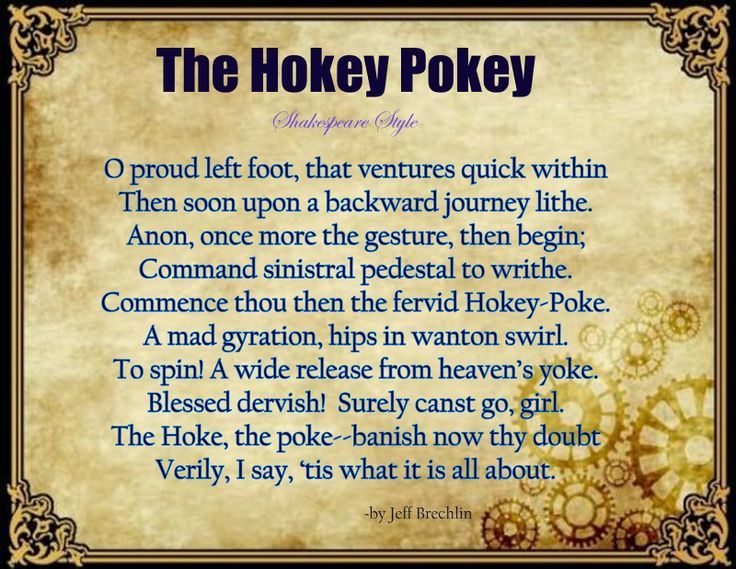
My quest to contribute to the body of sport literature knowledge resulted in the academic publication on the topic of Shakespeare’s use of falconry in the plays (the full citation of that paper appears below), parts of which, with copyright permission were used in this blog; this was my first of many presentations and publications on sport literature topics and I felt a lot of satisfaction in making this unique contribution. Thus, I tumble home to the lure of sport in general, to the point of its literature, and to the joy of the pitch and perspective in both playing and reading about sport and the meanings experienced in both ventures.
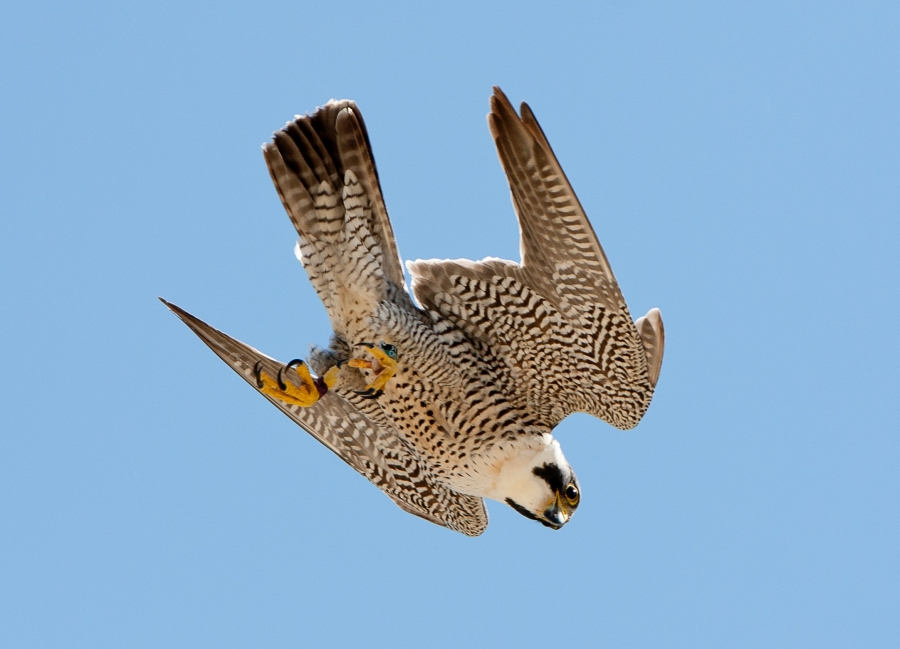
A peregrine falcon in full hunting dive; this hawk is the fastest bird on earth often diving at 375 km per hour
~ ~ ~
Don Morrow, Sport as Metaphor: Shakespeare’s Use of Falconry in the Early Plays. Aethlon: The Journal of Sport Literature (Spring, 1988), V : 2, pp. 119-129.
